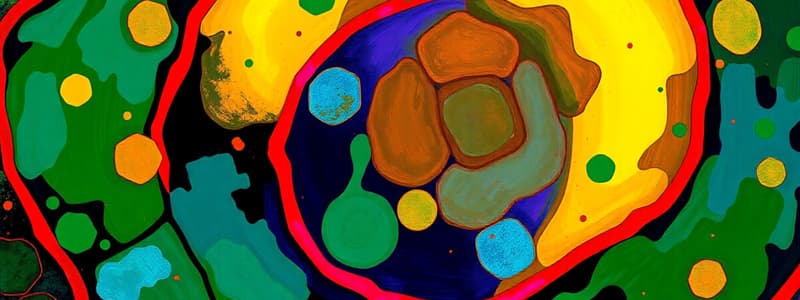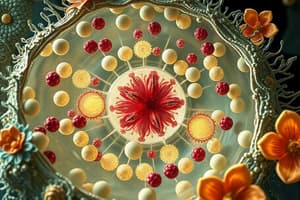Podcast
Questions and Answers
What is the purpose of using iodine solution when preparing the onion epidermal tissue for microscopic examination?
What is the purpose of using iodine solution when preparing the onion epidermal tissue for microscopic examination?
- To preserve the freshness of the tissue
- To increase the thickness of the tissue
- To stain starch and make cell structures distinct (correct)
- To enhance the transparency of the slide
What is indicated by the term 'magnification' in the context of microscopy?
What is indicated by the term 'magnification' in the context of microscopy?
- The brightness of the image
- The total number of samples analyzed
- The distance between the stage and the lens
- The size comparison of image to object (correct)
Which of the following describes a proper technique for placing a cover-slip on the microscope slide?
Which of the following describes a proper technique for placing a cover-slip on the microscope slide?
- Lowering it straight down to avoid trapping air
- Heating it to reduce contact with the slide
- Flipping it over before placing it on the slide
- Resting one edge against the tissue at a 45-degree angle (correct)
Why is it important to leave the slide for about 5 minutes after adding iodine solution?
Why is it important to leave the slide for about 5 minutes after adding iodine solution?
What effect do air bubbles have when viewing the specimen under a microscope?
What effect do air bubbles have when viewing the specimen under a microscope?
What should be done with the remaining onion tissue after cutting out a 1 cm square for the slide?
What should be done with the remaining onion tissue after cutting out a 1 cm square for the slide?
Which of the following modified cells is NOT mentioned as a part of cytoplasm modification?
Which of the following modified cells is NOT mentioned as a part of cytoplasm modification?
During the microscopic examination, what should be the first step concerning the objective lens?
During the microscopic examination, what should be the first step concerning the objective lens?
Which part of the onion bulb leaf is primarily used for the microscope slide preparation?
Which part of the onion bulb leaf is primarily used for the microscope slide preparation?
What color does the iodine stain the cell nuclei in the onion epidermal tissue?
What color does the iodine stain the cell nuclei in the onion epidermal tissue?
What is a primary difference between plant and animal cells?
What is a primary difference between plant and animal cells?
Which structure is common to both plant and animal cells?
Which structure is common to both plant and animal cells?
What is the primary function of root hair cells?
What is the primary function of root hair cells?
Which adaptation helps xylem vessels perform their function efficiently?
Which adaptation helps xylem vessels perform their function efficiently?
How are muscle cells adapted for their function?
How are muscle cells adapted for their function?
Which level of organization directly follows 'cell'?
Which level of organization directly follows 'cell'?
What is a characteristic feature of animal cells compared to plant cells?
What is a characteristic feature of animal cells compared to plant cells?
What type of modification do xylem vessels undergo?
What type of modification do xylem vessels undergo?
What is a common feature of modified cells?
What is a common feature of modified cells?
What describes the function of tissues?
What describes the function of tissues?
Flashcards are hidden until you start studying
Study Notes
Similarities Between Plant and Animal Cells
- Both plant and animal cells have a cell membrane, cytoplasm, nucleus, and mitochondria.
Differences Between Plant and Animal Cells
- Animal cells lack a cell wall, have small or temporary vacuoles, and do not contain chloroplasts. They usually store energy as glycogen..
- Plant cells have a cell wall made of cellulose, a large permanent sap vacuole, usually contain chloroplasts, and store energy as starch.
Levels of Organization
- Cell: The basic structural and functional unit of all living organisms. Examples include palisade cells and kidney cells.
- Tissue: A group of similar cells working together to perform a specific function. Examples include xylem and phloem.
- Organ: A group of different tissues working together to perform a particular function. Examples include leaves, roots, liver, and heart.
- Organ System: A group of organs working together with closely related functions. Examples include the circulatory system and respiratory system in animals, and the shoot system and root system in plants.
Modification
- A change in the shape or structure of a cell or organism to adapt to a specific function.
Modified Cells
- Root Hair Cells: Modified for absorption of water and minerals.
- Have a large surface area due to finger-like projections.
- Contain many mitochondria to produce energy.
- Have a large, concentrated sap vacuole for water absorption by osmosis.
- Secrete a viscous substance that helps with water absorption and prevents rupture.
- Xylem Vessels: Modified for conduction of water and minerals, and support.
- Form fine tubes for water transport through capillary action.
- Have lignified walls for support and to prevent water leakage.
- Contain pits for water and mineral distribution.
- Lack cross walls, cytoplasm, and nuclei to minimize resistance to water flow.
- Muscle Cells: Modified for contraction and movement.
- Have many mitochondria for energy production.
- Can perform anaerobic respiration in addition to aerobic respiration for energy production.
- Store carbohydrates as glycogen for energy.
- Contain contractile filaments in their cytoplasm.
Other Modified Cells
- Ciliated Epithelium: Cells with cilia for movement.
- Sperm Cells: Cells adapted for fertilization.
- Red Blood Cells: Cells specialized for oxygen transport.
Magnification
- Refers to the number of times an image appears larger than the actual object.
- Magnification = Image size / Actual size.
Preparing a Microscope Slide
- Procedure:
- Peel a piece of epidermal tissue from an onion bulb leaf.
- Cut a 1 cm square of tissue.
- Place the tissue on a glass microscope slide.
- Add iodine solution to stain starch and distinguish cell parts.
- Gently lower a cover slip over the tissue at an angle to avoid air bubbles.
- Allow the slide to sit for 5 minutes for the stain to react.
- View the slide under a microscope, starting with the lowest power objective and gradually increasing magnification.
Studying That Suits You
Use AI to generate personalized quizzes and flashcards to suit your learning preferences.




